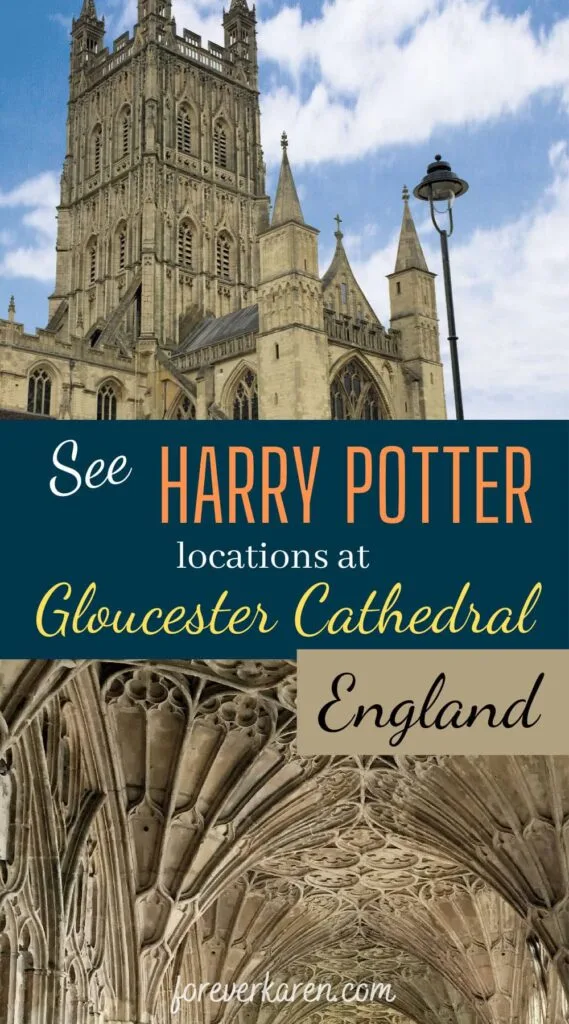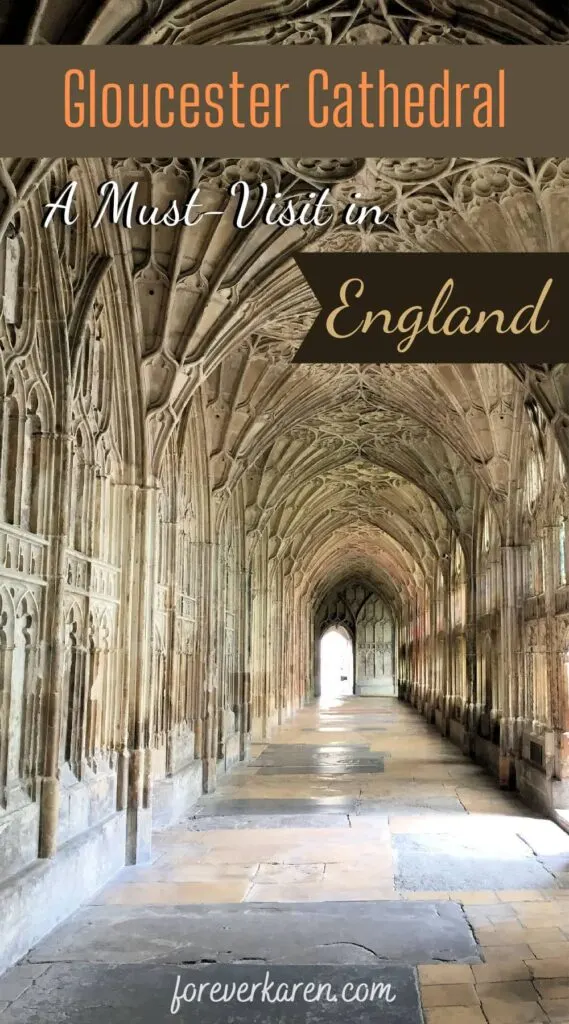
Harry Potter fans flock to Gloucester Cathedral in southwest England to see the monastic cloisters featured in its films. Potter fan or not, its magnificent gothic architecture mesmerizes every visitor with its revolving architectural styles that transpired over hundreds of years.
While many come to worship in this fantastic building, others visit to enjoy the tranquility of browsing its nooks and crannies.
While I have been to the medieval Cathedral in Gloucester several times, its limestone exterior and jaw-dropping interior still take my breath away. In fact, it’s one of the top cathedrals in England.
Where Is Gloucester Cathedral?
- Location: 12 College Green, Gloucester | Open: Mon to Sat 10 am to 5 pm, Sun noon to 5 pm
By vehicle, take the M5 and follow the signage. Located in the center of Gloucester, it’s just 6 miles from the motorway. Alternatively, visitors can catch a train to Gloucester Railway Station and walk for ten minutes to the cathedral.
Other nearby attractions that are worthy of visiting are Winchcombe’s Sudeley Castle, also accessible off the M5, and Painswick, a beautiful Cotswold village. Should you drive as I did, Gloucester Cathedral has no public parking, but there are many paid parking lots nearby.
I parked at Westgate Street car park, a short distance away. Do note, that some parking lots have a two-hour limit, and some offer free parking on Sundays. Due to the attraction’s busyness, these fill up fast, especially on weekends.
While the cathedral does not charge an entrance fee, they welcome a suggested donation of GBP 5.00. Since it costs a whopping GBP 6,000 a day to keep the doors open, we gladly donated.
Gloucester Cathedral’s History
The original Cathedral was erected between 678 and 681 but, over the years, underwent many modifications. The earliest part of the structure seen today dates back to 1100 when its full name was Cathedral Church of Saint Peter and Holy and Indivisible Trinity. That’s quite a mouthful!
In 1540, Henry VIII ordered the dissolution of all monasteries so, the abbey became known as Gloucester Cathedral. Thankfully, that’s a name I can remember.
During the Norman Conquest in 1066, Serlo, the appointed abbot, started constructing the present-day building. The Norman Nave, Chapter House, and Crypt dating from the 11th century remain. However, workers completed the majority of the work in the 13th century.
Another century later, the architectural details and ornate décor adorned the bones of the structure, making it the impressive Cathedral seen today.
Like many famous places of worship, the Cathedral serves as a burial place for clergy and notable people. King Edward II may be the most famous of them, but the house of worship has many Bishops of Gloucester interned there.
Wandering the aisles and exploring the corridors, I read the burial plaques on walls, floors, and marble tombs. Admiring the stained-glass windows, I even found one dedicated to the Cathedral’s organist, Charles Hartford-Llyod.
The holy place hosts happy events like the coronation of King Henry III. Given its fantastic interior, moviemakers have featured Gloucester Cathedral in many films such as Harry Potter, Doctor Who, and Sherlock.
Gloucester Cathedral’s Exterior
While most visit Gloucester Cathedral to admire its magnificent cloisters, take some time to walk around the outside too. I particularly love the butter-colored stone, typical of many buildings in the Cotswolds.
The predominant material, Oolitic limestone, came from the nearby village of Painswick. Due to its abundance, many famous buildings used this stone, including the more famous London residence, Buckingham Palace.
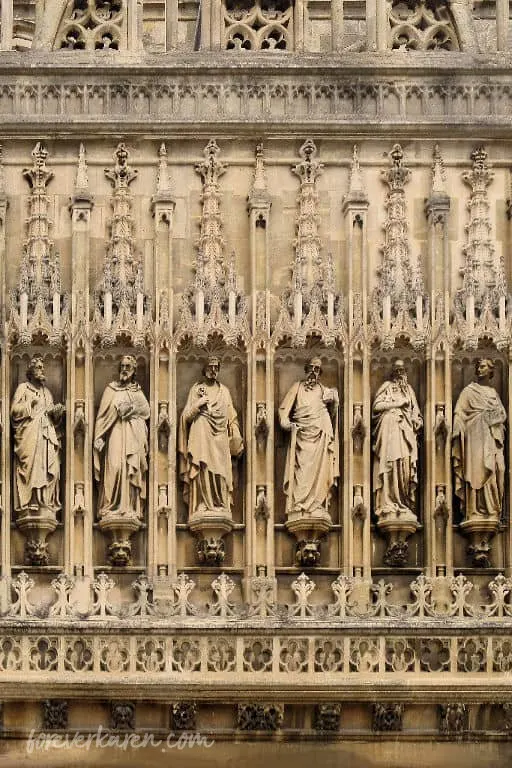
The southwest corner offers the best views, with its grand central tower ascending 69 meters or 225 feet above the Cathedral. Visitors can easily spot its peak from miles away.
At the South Porch entrance, look above the doorway. The stonework features six figures representing the founders of the initial church. On either side of the arched entrance, another six figures greet guests upon their arrival.
These structures are not original to the Cathedral. Added in 1871, James Frank Redfern sculpted these incredible figures. The attached photo shows these figures which are in remarkable condition, considering their age.
Gloucester Cathedral’s Interior
Entering the Cathedral through the west door, I was blown away by its grandeur. My eyes were drawn upwards to a white vaulted ceiling supported by tall, circular pillars. After the original wooden roof succumbed to fire, monks, replaced it with a more durable stone structure.
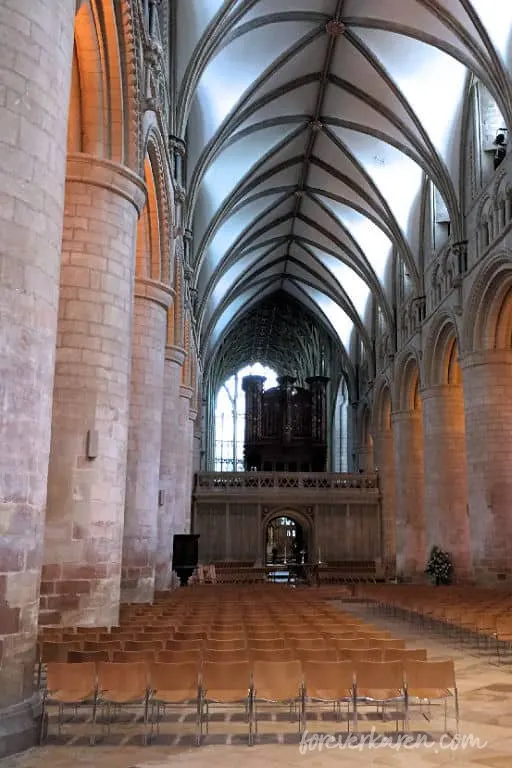
With light filtering through the upper windows and upwards lighting within the Cathedral, this was truly a tranquil space, perfect for prayer.
The Nave’s towering pillars were erected by Abbot Serlo, although much of the surrounding décor dates from the 1300s. Compared to other parts of the Cathedral, the Nave seemed relatively simple and less dramatic than similar Gothic structures.
The Norman Nave connects to the Choir Stalls, and on each side, the south and north aisles have the same white-plastered ceiling.
With some smaller chapels within the Cathedral, I found myself wandering for a few hours, admiring every inch of the architecture and discovering new treasures through every doorway. Through exploration, here are some of the stand-out areas for me.
The Choir Stalls And Presbytery
The Choir Stalls are a marvel in construction with its Perpendicular Gothic architecture created around 1370. Here and above the adjoining Presbytery, the ceiling changes to a more elaborate fan-vaulted style that I could have admired forever.

I was in awe of the craftsmanship, from the intricately carved wooden stalls and ornately tiled floor to the beautiful organ above.
Further ahead, the Quire, surrounding the high altar, mesmerizes visitors with its magnificent stained glass window, famously known as the Great East Window. Measuring 22 meters high by 12 meters wide (72 by 38 feet), it’s as big as a tennis court.
At the time of installation, it was the largest window in the world. Today, York Minster’s East Window has the title for the largest medieval window in Great Britain. Gloucester Cathedral’s East Window takes second place.
Above the Choir Stalls and the Presbytery, the elaborate ceiling demonstrates the additions and changes in architecture. Created between 1331 and 1355, I admired the ornate, painted ceiling.
It was fashioned in the Rayonnant style, famous in France during King Louis IX’s reign. Enhanced in hues of red and blue, with gold-gilded angels and flowerets, I was blown away by the craftsmanship.
On either side of the Presbytery, the North and South Transepts lead to the Ambulatories and one of my favorite places, The Lady Chapel. The above Gloucester Cathedral map shows the main floor layout.
The Lady Chapel

Built in the 15th century, I admired the intimate space of The Lady Chapel. When I visited, it had just completed a three-year restoration of both exterior and interior.
The stonework looked remarkably new, from its deep cleaning and the latest lighting added a sense of airiness to the space.
Dedicated to the Blessed Virgin Mary, the mother of Jesus, “Our Lady” Chapel is adorned with stained glass windows. Most of these dated from the 1900s, and artist Christopher Whall created them.
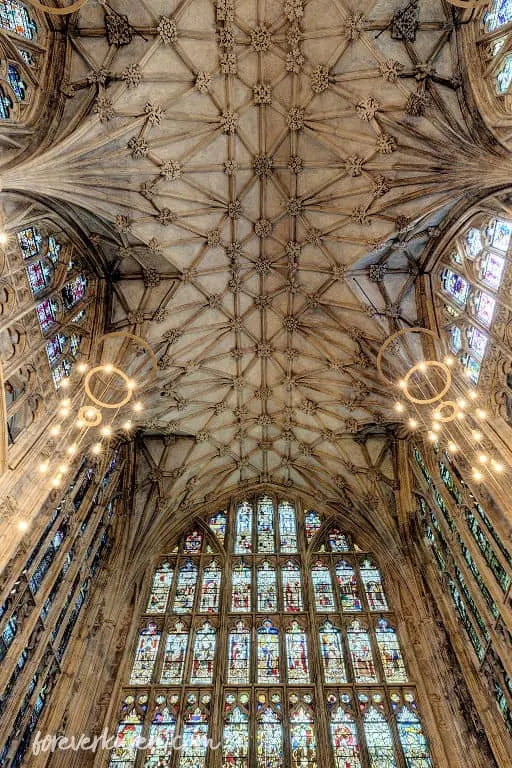
Off to the right side, the Musician’s Chapel has unusual stained glass windows. Based on their distinctive style, they obviously date from a newer era.
Within the Lady Chapel, I admired a beautiful memorial to Elizabeth Williams, who died during childbirth in 1622. The humbling monument features her child cloaked in a chrisom shroud, laying by her side.
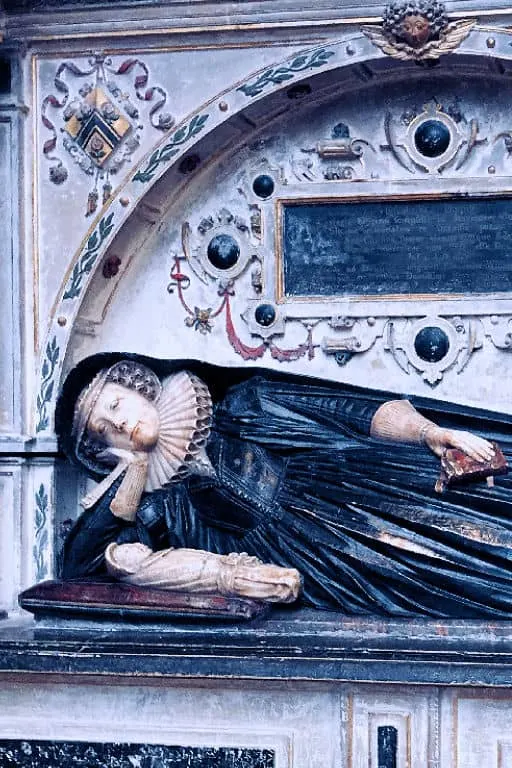
The Crypt
During my visit, the Cathedral had no access to the Crypt. Accessed from the South Transept, visitors view some of the earliest parts of the structure, which sit eight feet below ground level. Throughout the day, volunteers guide visitors through the Crypt.
There’s no fee to access the Crypt. However, should you want to take photos, the Cathedral suggests a donation to take pictures. I happily donated and was given a sticker to wear on my jacket.
Even though the outer walls of the Crypt are ten feet thick, it experiences frequent flooding. Initially, the subterranean chapels hosted services and events such as funerals. Gloucester cathedral’s Crypt is one of four apsidal cathedral Crypts in England.
The Cloisters
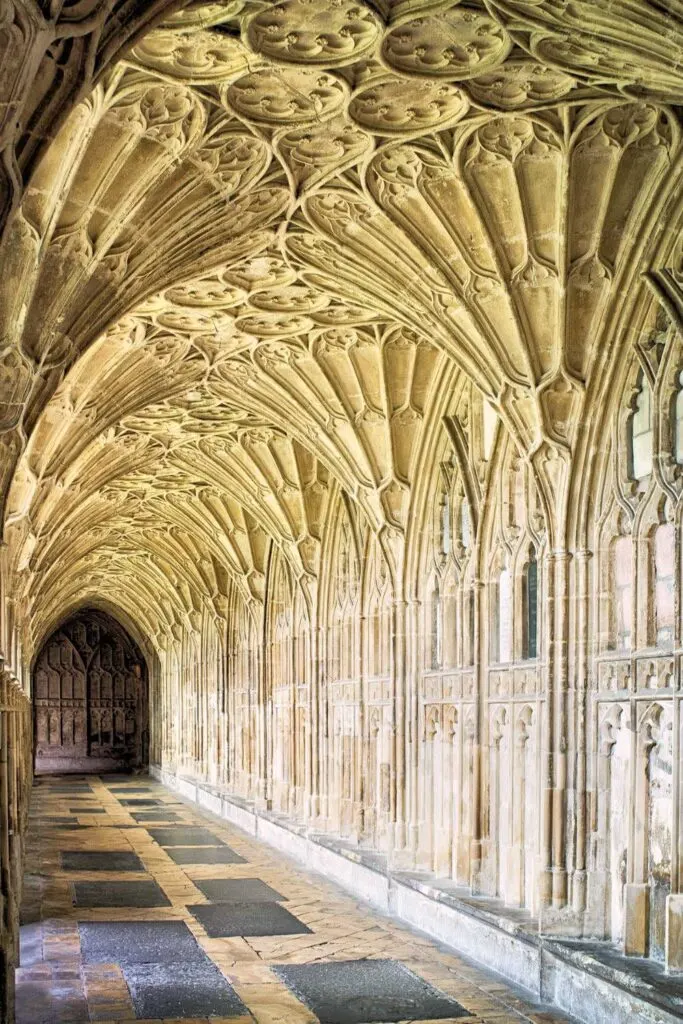
Many visitors come to see Gloucester Cathedral because of its appearances in several Harry Potter motion picture films. The north aisle provides access to the famous Cloisters from either end of its hallway.
The Cloisters are a marvel of design with stunning fan ceilings and stone walls encasing small stained glass windows. The picture-postcard setting is what draws many tourists to the Cotwolds Cathedral.
Archaeologists believe the Cloisters were designed from a cathedral of trees that arch and meet high above the ground. Wherever the inspiration came from, I found them stunning!
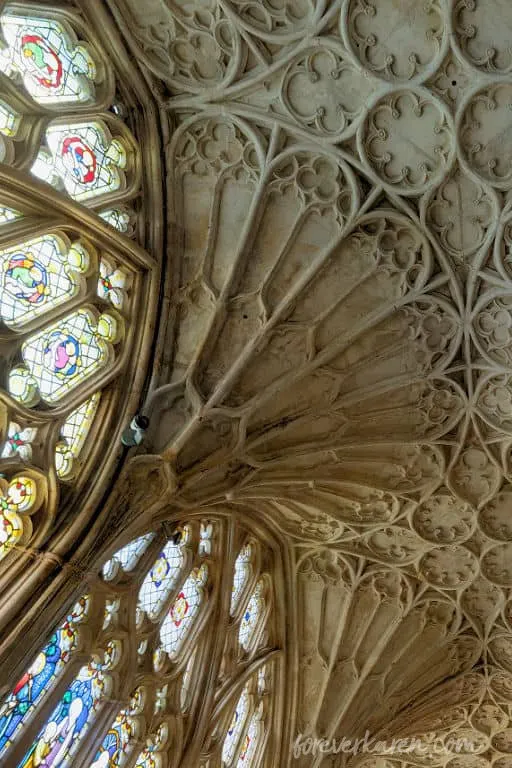
Constructed in the 14th century, the cloistered hallways provide access to the inner courtyard or “Garth.” Depending on the time of day, the light filtering through the mullioned windowed cast beautiful shadows on the masonry.
In the north walk, the North Lavatorium has a stone trough, once used by monks for cleaning and bathing. Initially, the monks used the cloisters for work, study, and living.
Browsing the Cloisters, I viewed niche spaces called “carrels” in the south walk. The carrels once housed desks used by the monks to study.
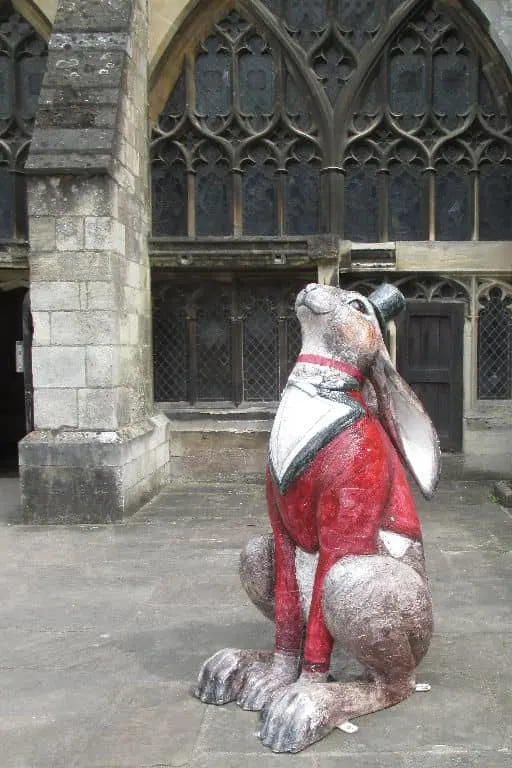
Outside, the garth features an enclosed garden surrounded by the Cloisters. In the center, a small water fountain and park benches provide a space of tranquility.
I visited during the Cotswold AONB Hare Trail event, so I was pleasantly surprised to find a beautiful five-foot-high hare in the garth. Wearing a top hat and donning a red jacket, he looked mighty dapper in his surroundings.
The Tribune Galleries
From the North and South Transepts, winding narrow staircases lead up to the second level. Here, the Tribune Galleries and Bridge Chapel overlook the Cathedral, providing different views.
In the one Gallery, visitors can dress up in period costumes and relive medieval times. So, will you be a mighty monarch or a penniless peasant? I chose the Queen’s outfit, and Brian dressed as a Pope.
In the adjoining Gallery, we learned the difference in architectural styles. Lighted billboards told the history, explained the stained glass-making process, and detailed the Cathedral’s construction.
The Tombs
While the cathedral serves as a resting place for many individuals, it also enshrouded three royalty members. King Edward II’s tomb stands out amongst the others for its spectacular limestone carvings. Located on the north side of the Presbytery, I was in awe of the detailed craftsmanship.
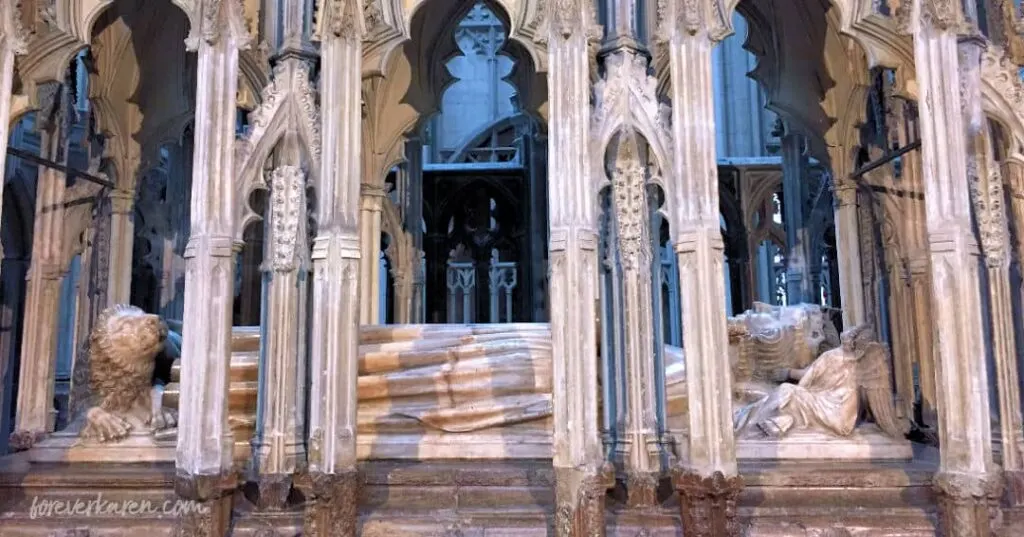
The marble figure lay in a saintly pose as two angels cradle his head. On one hand, an orb, and on the other, a specter. At his feet, a resting lion sits, vigilantly guarding the king.
Interestingly, he was an unpopular king, and his peaceful pose contrasts strongly with his brutal death at Berkeley Castle.
The second memorial belongs to the eldest son of William the Conqueror, Robert Curthose. His colorful effigy immortalizes the warrior once imprisoned for the last twenty years of his life. In 1134, Robert died in his early eighties during his imprisonment in Cardiff Castle.

Located in the North Ambulatory, King Osric’s effigy was created two hundred years after King Edward II’s tomb. Osric’s claim to fame was founding two prominent religious structures, Bath Abbey and Gloucester Cathedral.
Final Thoughts
Other exciting exhibits include the processional cross, circa 1923. Queen Elizabeth used it regularly for processions and at her coronation in 1953.
Should you have the time, consider a guided tour of the Cathedral’s tower. After a couple of hours, I felt I got a good overview of this spectacular Gloucester attraction.
However, I could have spent another hour exploring its nooks a little more closely. Gloucester Cathedral isn’t a place you can see in an hour. Its vastness and grandeur need savoring in baby steps.
Happy travels ~ Karen
